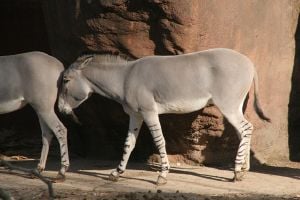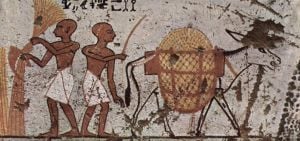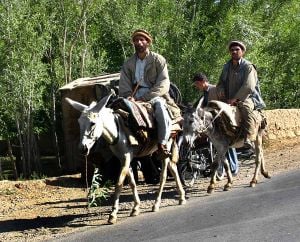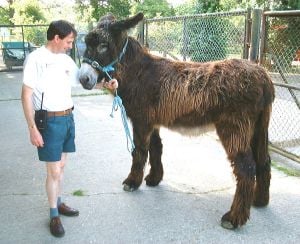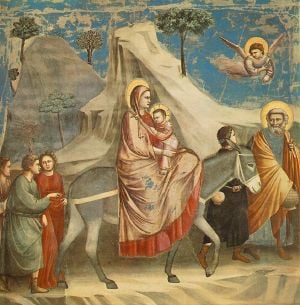Difference between revisions of "Donkey" - New World Encyclopedia
| Line 29: | Line 29: | ||
The wild ass today is found only in small areas in northeast Africa and is an endangered species, mainly because of hunting. At one time there were at least four subspecies of wild ass. Today only the Somali wild ass (''E. asinius somalicus'') survives. It is thought that the donkey is derived from the Nubian wild ass (''E. asinus africanus'') which became extinct in the Twentieth Century (Huffman 2006). | The wild ass today is found only in small areas in northeast Africa and is an endangered species, mainly because of hunting. At one time there were at least four subspecies of wild ass. Today only the Somali wild ass (''E. asinius somalicus'') survives. It is thought that the donkey is derived from the Nubian wild ass (''E. asinus africanus'') which became extinct in the Twentieth Century (Huffman 2006). | ||
| − | Closely related to the wild ass are the other members of the horse family (all of which are | + | Closely related to the wild ass are the other members of the horse family (all of which are endangered in the wild): The horse (''Equus caballus''), the onager (''E. hemionus''), the kiang (''E. kiang''), Grevy's zebra (''E. greyi''), Burcell's zebra (''E. burchelli''), and the mountain zebra (''E. zebra''). All of these species can interbreed with each other, although the offspring are sterile, except in extremely rare individual cases. (Another horse family species, the quagga, ''E. quagga'', became extinct in 1883. There are populations of feral donkeys and horses, that is domesticated animals that have returned to the wild, on several continents. However, the only true wild horse still living is Przewalski's wild horse of central Asia. In the past it was given the name ''E. przewalskii'' but now most authorities consider it the same species as domestic horses, ''E. caballus''. It is now recovering from near extinction and being reintroduced to the wild) (Nowak 1986) (Huffman 2006). |
| − | == | + | ==Donkey history== |
[[Image:Maler der Grabkammer des Panehsi 001.jpg|thumb|left|Ancient Egyptian donkey]] | [[Image:Maler der Grabkammer des Panehsi 001.jpg|thumb|left|Ancient Egyptian donkey]] | ||
[[Image:Donkeys in Afghanistan.jpg|thumb|Donkeys ridden in Afghanistan]] | [[Image:Donkeys in Afghanistan.jpg|thumb|Donkeys ridden in Afghanistan]] | ||
| Line 42: | Line 42: | ||
:"The mule is a perfect example of hybrid vigour - as a beast of burden it has more stamina and endurance, can carry heavier loads, and is more sure-footed than either the ass or the horse." | :"The mule is a perfect example of hybrid vigour - as a beast of burden it has more stamina and endurance, can carry heavier loads, and is more sure-footed than either the ass or the horse." | ||
[[Image:Baudet du Poitou.jpg|thumb|Poitou Donkey]] | [[Image:Baudet du Poitou.jpg|thumb|Poitou Donkey]] | ||
| − | Donkeys, along with horses and mules, gradually spread around the world. In 1495, the donkey was introduced to the [[New World]] by [[Columbus]]. Different breeds of donkeys were developed, including the Poitou of France and the Mammoth Jack Stock of the United States (said to be originally developed by [[George Washington]]) which were both bred to sire mules. Both are larger than average donkeys, around 1.3 to 1.5 meters (51 to 59 inches) tall at the shoulders. In the Twentieth Century miniature donkeys, | + | Donkeys, along with horses and mules, gradually spread around the world. In 1495, the donkey was introduced to the [[New World]] by [[Columbus]]. Different breeds of donkeys were developed, including the Poitou of France and the Mammoth Jack Stock of the United States (said to be originally developed by [[George Washington]]) which were both bred to sire mules. Both are larger than average donkeys, around 1.3 to 1.5 meters (51 to 59 inches) tall at the shoulders. In the Twentieth Century miniature donkeys, 0.9 meters (36 inches) tall or shorter, became popular as pets (OSU 2006). |
| − | == | + | ==Donkey traits== |
Donkeys have a reputation for stubbornness, but this is due to some handlers' misinterpretation of their highly-developed sense of self preservation. It is difficult to force or frighten a donkey into doing something it sees as contrary to its own best interest, as opposed to horses who are much more willing to, for example, go along a path with unsafe footing. | Donkeys have a reputation for stubbornness, but this is due to some handlers' misinterpretation of their highly-developed sense of self preservation. It is difficult to force or frighten a donkey into doing something it sees as contrary to its own best interest, as opposed to horses who are much more willing to, for example, go along a path with unsafe footing. | ||
| Line 51: | Line 51: | ||
Once a person has earned their confidence they can be willing and companionable partners and very dependable in work and recreation. For this reason, they are now commonly kept as [[pet]]s in countries where their use as beasts of burden has disappeared. They are also popular for giving rides to children in holiday resorts or other leisure contexts. | Once a person has earned their confidence they can be willing and companionable partners and very dependable in work and recreation. For this reason, they are now commonly kept as [[pet]]s in countries where their use as beasts of burden has disappeared. They are also popular for giving rides to children in holiday resorts or other leisure contexts. | ||
| + | |||
| + | ==Donkeys in religion== | ||
| + | [[Image:Giotto - Scrovegni - -20- - Flight into Egypt.jpg|thumb|left|Mary and Jesus riding a donkey, painting by Giotto]] | ||
| + | In ancient [[Greece]] the donkey was associated with Dionysus. the god of wine. In ancient [[Rome]] donkeys were used as sacrificial animals. In the [[Bible]] donkeys are mentioned about 100 times, most famously in the stories of Samson and Balaam in the Old Testament and in the story of [[Jesus]] in the New Testament. According to the Bible Jesus rode into [[Jerusalem]] on a donkey, fulfilling an Old Testament prophecy. His mother, Mary, is traditionally pictured riding a donkey and donkeys are often used in nativity scenes at [[Christmas]] time. | ||
==Present status== | ==Present status== | ||
| Line 57: | Line 61: | ||
There are about 44 million donkeys today. [[China]] has the most with 11 million, followed by [[Ethiopia]] and [[Mexico]]. Most of them (probably over 95%) used for the same types of work that donkeys have been doing for 6000 years. Their most common role is for transport, whether riding, pack transport or pulling carts. They may also be used for farm tillage, threshing, raising water, milling, and other operations. Other donkeys are used to sire mules, as companions for horses, to guard sheep, and as pets. A few are milked or raised for meat (Starkey 1997). | There are about 44 million donkeys today. [[China]] has the most with 11 million, followed by [[Ethiopia]] and [[Mexico]]. Most of them (probably over 95%) used for the same types of work that donkeys have been doing for 6000 years. Their most common role is for transport, whether riding, pack transport or pulling carts. They may also be used for farm tillage, threshing, raising water, milling, and other operations. Other donkeys are used to sire mules, as companions for horses, to guard sheep, and as pets. A few are milked or raised for meat (Starkey 1997). | ||
| − | The number of donkeys in the world continues to increase, as it has steadily thoughout history. Some factors contributing to this are the increased human population, progress in economic development and social stability in poor rural areas, and the | + | The number of donkeys in the world continues to increase, as it has steadily thoughout history. Some factors contributing to this are the increased human population, progress in economic development and social stability in poor rural areas, and the rising price of gasoline which makes other forms of transport more expensive (Starkey 1997). |
In prosperous countries, the welfare of donkeys both at home and abroad has recently become a concern, and a number of sanctuaries for retired donkeys have been set up. | In prosperous countries, the welfare of donkeys both at home and abroad has recently become a concern, and a number of sanctuaries for retired donkeys have been set up. | ||
| − | |||
| − | |||
| − | |||
| − | |||
| − | |||
| − | |||
| − | |||
| − | |||
| − | |||
| − | |||
| − | |||
| − | |||
| − | |||
| − | |||
| − | |||
| − | |||
| − | |||
==References== | ==References== | ||
Revision as of 00:49, 4 December 2006
| Donkey Conservation status: Domesticated | ||||||||||||||
|---|---|---|---|---|---|---|---|---|---|---|---|---|---|---|
| Donkey | ||||||||||||||
| Scientific classification | ||||||||||||||
| ||||||||||||||
| Binomial name | ||||||||||||||
| Equus asinus Linnaeus, 1758 |
The donkey or ass, Equus asinus, is a member of the horse family, Equidae, of the order Perissodactyla, odd-toed ungulates (hoofed mammals). The word donkey refers to the domesticated E. asinus, while its wild ancestor, also E. asinus, is called the wild ass.
Donkeys were first domesticated around 4000 B.C.E. and have spread around the world in the company of humans. They continue to fill important roles in many places today and are increasing in numbers and popularity.
The wild ass
Wild asses are native to North Africa and the Arabian Peninsula. They are well suited to life in a desert or semi-desert environment. They stand about 125 to 145 cm (4.2 to 5.5 ft) tall at the shoulder and weigh about 275 kg (605 lb). They have tough digestive systems which can break down desert vegetation and extract moisture from food efficiently. They can also go without water for a fairly long time. Their large ears give them an excellent sense of hearing and help cool their blood.
Because of the sparse vegetation in their environment wild asses live separated from each other (except for mothers and young), unlike the tightly grouped herds of wild horses. They have very loud voices, which can be heard for over 3 km (2 miles) which helps them to keep in contact with other asses over the wide spaces of the desert.
Wild asses can run swiftly, almost as fast as a horse. But, unlike most hoofed mammals, their tendency is to not to flee right away from a potentially dangerous situation, but to investigate first before deciding what to do. When they need to they can defend themselves with kicks from both their front and hind legs.
The wild ass today is found only in small areas in northeast Africa and is an endangered species, mainly because of hunting. At one time there were at least four subspecies of wild ass. Today only the Somali wild ass (E. asinius somalicus) survives. It is thought that the donkey is derived from the Nubian wild ass (E. asinus africanus) which became extinct in the Twentieth Century (Huffman 2006).
Closely related to the wild ass are the other members of the horse family (all of which are endangered in the wild): The horse (Equus caballus), the onager (E. hemionus), the kiang (E. kiang), Grevy's zebra (E. greyi), Burcell's zebra (E. burchelli), and the mountain zebra (E. zebra). All of these species can interbreed with each other, although the offspring are sterile, except in extremely rare individual cases. (Another horse family species, the quagga, E. quagga, became extinct in 1883. There are populations of feral donkeys and horses, that is domesticated animals that have returned to the wild, on several continents. However, the only true wild horse still living is Przewalski's wild horse of central Asia. In the past it was given the name E. przewalskii but now most authorities consider it the same species as domestic horses, E. caballus. It is now recovering from near extinction and being reintroduced to the wild) (Nowak 1986) (Huffman 2006).
Donkey history
Wild asses were hunted by humans for their meat and skins. It is thought that hunters sometimes found orphaned colts and took them to their homes to keep as pets. Asses adapted well to conditions in human settlements and were able to breed in captivity. Over time this gave rise to the domesticated donkey. The first evidence of the donkey comes from Egypt around 4,000 B.C.E. (Clutton-Brock 1999).
The donkey became an important pack animal for people living in the Egyptian and Nubian regions as they can easily carry 20 to 30 percent of their own body weight and can also be used to pull a plow and as a dairy animal. By 1800 B.C.E., the donkey had reached the Middle East where the trading city of Damascus was referred to as the “City of Asses” in cuneiform texts. Syria produced at least three breeds of donkeys, including a saddle breed with a graceful, easy gait. These were favored by women.
Soon after the domesticated horse was introduced to the Middle East, around 1500 B.C.E., donkeys and horses began to be bred together giving birth to mules. (A mule is the offspring of a male donkey and a female horse. The mating of a male horse and a female donkey produces a hinny.) As a work animal the mule is superior to both the donkey and the horse. Domestic animal expert Juliet Clutton-Brook writes (Clutton-Brock 1999):
- "The mule is a perfect example of hybrid vigour - as a beast of burden it has more stamina and endurance, can carry heavier loads, and is more sure-footed than either the ass or the horse."
Donkeys, along with horses and mules, gradually spread around the world. In 1495, the donkey was introduced to the New World by Columbus. Different breeds of donkeys were developed, including the Poitou of France and the Mammoth Jack Stock of the United States (said to be originally developed by George Washington) which were both bred to sire mules. Both are larger than average donkeys, around 1.3 to 1.5 meters (51 to 59 inches) tall at the shoulders. In the Twentieth Century miniature donkeys, 0.9 meters (36 inches) tall or shorter, became popular as pets (OSU 2006).
Donkey traits
Donkeys have a reputation for stubbornness, but this is due to some handlers' misinterpretation of their highly-developed sense of self preservation. It is difficult to force or frighten a donkey into doing something it sees as contrary to its own best interest, as opposed to horses who are much more willing to, for example, go along a path with unsafe footing.
Although formal studies of their behaviour and cognition are rather limited, donkeys appear to be quite intelligent, cautious, friendly, playful, and eager to learn. They are many times fielded with horses due to a perceived calming effect on nervous horses. If a donkey is introduced to a mare and foal, the foal will often turn to the donkey for support after it has left its mother.[1]
Once a person has earned their confidence they can be willing and companionable partners and very dependable in work and recreation. For this reason, they are now commonly kept as pets in countries where their use as beasts of burden has disappeared. They are also popular for giving rides to children in holiday resorts or other leisure contexts.
Donkeys in religion
In ancient Greece the donkey was associated with Dionysus. the god of wine. In ancient Rome donkeys were used as sacrificial animals. In the Bible donkeys are mentioned about 100 times, most famously in the stories of Samson and Balaam in the Old Testament and in the story of Jesus in the New Testament. According to the Bible Jesus rode into Jerusalem on a donkey, fulfilling an Old Testament prophecy. His mother, Mary, is traditionally pictured riding a donkey and donkeys are often used in nativity scenes at Christmas time.
Present status
There are about 44 million donkeys today. China has the most with 11 million, followed by Ethiopia and Mexico. Most of them (probably over 95%) used for the same types of work that donkeys have been doing for 6000 years. Their most common role is for transport, whether riding, pack transport or pulling carts. They may also be used for farm tillage, threshing, raising water, milling, and other operations. Other donkeys are used to sire mules, as companions for horses, to guard sheep, and as pets. A few are milked or raised for meat (Starkey 1997).
The number of donkeys in the world continues to increase, as it has steadily thoughout history. Some factors contributing to this are the increased human population, progress in economic development and social stability in poor rural areas, and the rising price of gasoline which makes other forms of transport more expensive (Starkey 1997).
In prosperous countries, the welfare of donkeys both at home and abroad has recently become a concern, and a number of sanctuaries for retired donkeys have been set up.
ReferencesISBN links support NWE through referral fees
- Blench, R. 2000. "The history and spread of donkeys in Africa ". Animal Traction Network for Eastern and Southern Africa (ATNESA)
- Clutton-Brook, J. 1999. A Natural History of Domesticated Mammals. Cambridge, UK: Cambridge University Press. ISBN 0521634954
- The Donkey Sanctuary. 2006. Website. [1]
- Huffman, B. 2006. The Ultimate Ungulate Page. "Equus asinus" [2]
- Huggins, B. 2002. "Equus asinus" (On-line), Animal Diversity Web. Accessed November 29, 2006 at [3]
- International Museum of the Horse (IMH). 1998. "Donkey" [4]
- Invasive Species Specialist Group (ISSG). 2006. "Global Invasive Species Database: Equus asinus" [5]
- Nowak, R.M. and Paradiso, J.L. 1983. Walker's Mammals of the World. Baltimore, Maryland, USA : The Johns Hopkins University Press ISBN 0801825253
- Oklahoma State University (OSU). 2006. Breeds of Livestock. [6]
- Starkey, P. and M. 1997 "Regional and world trends in donkey populations". Animal Traction Network for Eastern and Southern Africa (ATNESA) [7]
- Voelker, W. 1986. The Natural History of Living Mammals. Medford, New Jersey, USA : Plexus Publishing, Inc. ISBN 0937548081
Credits
New World Encyclopedia writers and editors rewrote and completed the Wikipedia article in accordance with New World Encyclopedia standards. This article abides by terms of the Creative Commons CC-by-sa 3.0 License (CC-by-sa), which may be used and disseminated with proper attribution. Credit is due under the terms of this license that can reference both the New World Encyclopedia contributors and the selfless volunteer contributors of the Wikimedia Foundation. To cite this article click here for a list of acceptable citing formats.The history of earlier contributions by wikipedians is accessible to researchers here:
The history of this article since it was imported to New World Encyclopedia:
Note: Some restrictions may apply to use of individual images which are separately licensed.
